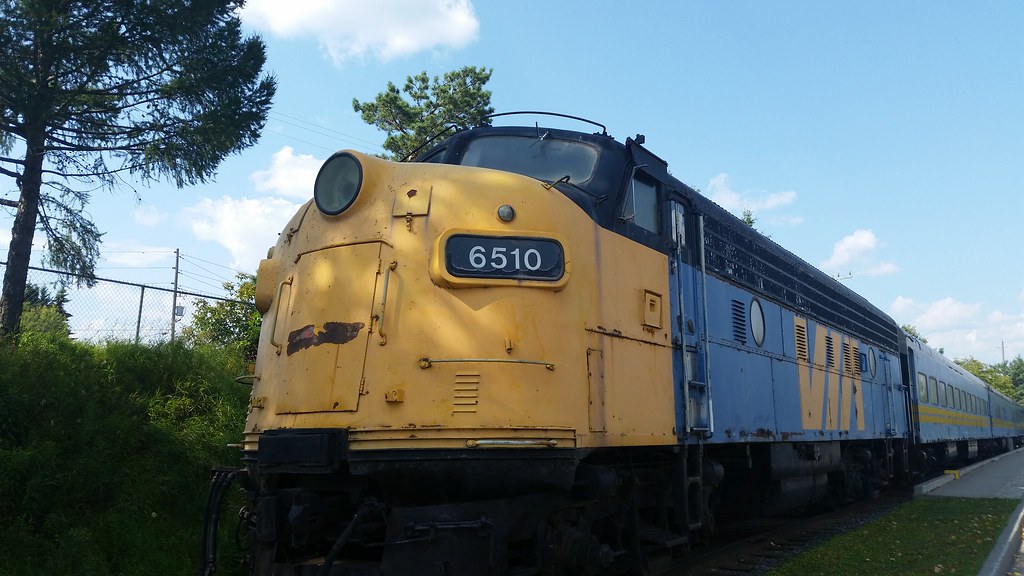
The train observation spot in Thunder Bay, located at the historic Port Arthur station, offers a picturesque view of passing trains against the backdrop of Lake Superior. This spot is popular among rail enthusiasts and photographers, providing a unique vantage point to observe both freight and passenger trains.
Photos
Sign in to upload photos
No Photos Yet
Be the first to share photos of this location!
Thunder Bay (Port) – Thunder Bay, Ontario, Canada | Train Spotting Location
Trainspotting Experience
A typical visit begins with the distant rumble of dynamic brakes as loaded grain trains descend the gentle grade toward the harbour. From publicly accessible berms and roadside pull-offs south of the mainline, watchers can observe CN and CP crews slowing to yard limits—horns echo against the silos—before the locomotives crawl past at roughly 15–25 km/h. Because movements are terminal-bound, engines linger longer than on a straight main-line dash, giving ample time to study power consists, buffer cars, and rolling stock markings. Expect some sudden bursts of metallic clanging when cut levers drop and remote-controlled switchers shuffle hoppers on ladder tracks. Even with the slower speeds, full-throttle departures back to the mainline create chest-thumping resonance, especially under still morning air.
Landscape, Setting & Local Atmosphere
The port sits at lake level, framed by the bluffs of the Nor’Wester Mountains to the south and an open sweep of Superior to the east. Elevation changes are modest near the water, yet a short walk upslope grants panoramic views of silvery rails curving alongside grain elevators and ore docks. Vegetation is typical boreal transition: jack pine pockets, hardy birch, and patches of wild grass thriving in rocky soil. Spring brings cool, crisp air with sudden fog banks rolling off the lake, giving photographs dramatic moodiness. Summers are pleasantly mild—highs near 22 °C—while autumn offers vibrant yellows against grey concrete structures. Winter spotting is feasible, though blowing snow and lake-effect squalls can obscure visibility; temperatures plunge well below freezing, so layered clothing is essential.
Type & Frequency of Train Activity
Traffic is almost entirely freight. Thunder Bay serves as one of Canada’s busiest grain ports, and both Canadian National and Canadian Pacific funnel prairie harvests here. On an average day, railfans can expect 8–12 unit grain trains combined from both carriers, with seasonal peaks during late summer and post-harvest months pushing the count toward 15 trains daily. Intermodal blocks are uncommon, though mixed freights occasionally appear carrying pulp, potash, or dimensional loads bound for the marine terminal. Train lengths often exceed 130 cars, stretching over 2 km, powered by two to four GE and EMD units—Dash-9s, ES44ACs, or SD70ACes are typical. Passenger service does not enter the port area; VIA Rail’s Canadian bypasses the waterfront several kilometres inland.
Best Angles for Photos & What Railfans Enjoy Most
• Eastern Sunlight: Early morning places the rising sun behind photographers positioned on the west side of the tracks, illuminating locomotive noses as they head lakeward.
• Elevator Backdrop: From the paved trail paralleling the Current River, shooters capture broadside views with the iconic Richardson and Viterra elevators towering above a string of yellow Saskatchewan hoppers—an unmistakable Thunder Bay signature.
• Elevated Ridge: A low hill near Island Drive offers a three-quarter overhead angle, ideal for framing trains, ships, and the Sleeping Giant peninsula in a single shot. Golden hour light washes the scene in warm tones, accentuating rust streaks and hopper graffiti.
Tripods are recommended for twilight work; sodium-vapor yard lights throw a warm glow on outbound consists, enabling striking night images.
Historical or Cultural Relevance
Rail service to the harbour dates back to the 1880s, when the Canadian Pacific completed its transcontinental link and chose Thunder Bay (then Port Arthur and Fort William) as its Lake Superior outlet. The port rapidly became a grain gateway, and many of today’s elevators trace their lineage to pre-World War I construction booms. Although modernized, the labyrinth of storage bins, marine legs, and balloon tracks still reflects that heritage. Nearby, bits of disused trackage and foundation footings from the long-gone Prince Arthur’s Landing passenger station provide tangible reminders of the golden age of Canadian railroading.
What Makes This Spot Different
Unlike rural passes or dense urban junctions, Thunder Bay combines industrial might with vast natural beauty: lake freighters queue only metres from roaring GEVOs, while bald eagles glide overhead. The convergence of two Class I railways at a single port creates diversity in paint schemes and operating practices absent at single-carrier yards. Add the consistency of grain traffic—reliably long, heavy, and photogenic—and railfans gain nearly guaranteed action against a backdrop that changes with every shift in lake light.
Seasonal Information
For train observation in Thunder Bay at the historic Port Arthur station, spring and fall offer mild weather and scenic views with blooming flowers or colorful foliage. Summer provides long daylight hours, while winter offers picturesque snowy scenes. Check local schedules for special seasonal train events.
Other Interesting Locations
Looking for more spots? Browse the complete list of train spotting locations.
Quick Information
Country
Canada
Region / State / Province
Ontario
City
Thunder Bay
Spot Type
Station
Best Times
Best hours to observe trains at Thunder Bay's Port Arthur station are during daylight, especially morning (7-9 AM) and evening (5-7 PM) for peak train activity.
Access & Amenities
Parking
Not available
Shelter
Not available
Restrooms
Not available
